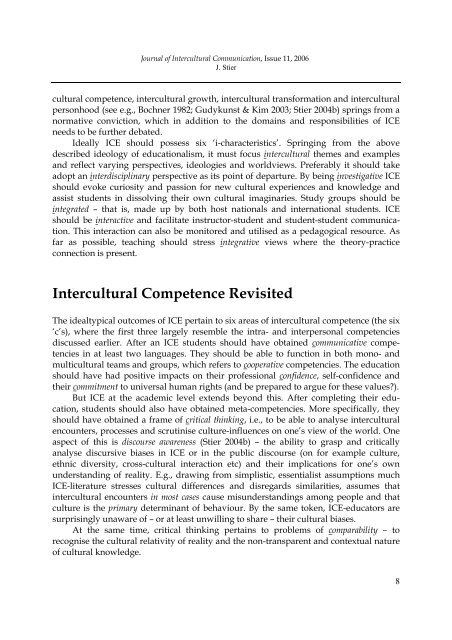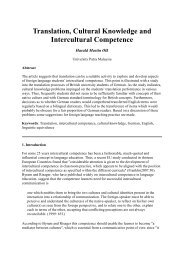Internationalisation, intercultural communication and intercultural ...
Internationalisation, intercultural communication and intercultural ...
Internationalisation, intercultural communication and intercultural ...
Create successful ePaper yourself
Turn your PDF publications into a flip-book with our unique Google optimized e-Paper software.
Journal of Intercultural Communication, Issue 11, 2006<br />
J. Stier<br />
cultural competence, <strong>intercultural</strong> growth, <strong>intercultural</strong> transformation <strong>and</strong> <strong>intercultural</strong><br />
personhood (see e.g., Bochner 1982; Gudykunst & Kim 2003; Stier 2004b) springs from a<br />
normative conviction, which in addition to the domains <strong>and</strong> responsibilities of ICE<br />
needs to be further debated.<br />
Ideally ICE should possess six ‘i-characteristics’. Springing from the above<br />
described ideology of educationalism, it must focus <strong>intercultural</strong> themes <strong>and</strong> examples<br />
<strong>and</strong> reflect varying perspectives, ideologies <strong>and</strong> worldviews. Preferably it should take<br />
adopt an interdisciplinary perspective as its point of departure. By being investigative ICE<br />
should evoke curiosity <strong>and</strong> passion for new cultural experiences <strong>and</strong> knowledge <strong>and</strong><br />
assist students in dissolving their own cultural imaginaries. Study groups should be<br />
integrated – that is, made up by both host nationals <strong>and</strong> international students. ICE<br />
should be interactive <strong>and</strong> facilitate instructor-student <strong>and</strong> student-student <strong>communication</strong>.<br />
This interaction can also be monitored <strong>and</strong> utilised as a pedagogical resource. As<br />
far as possible, teaching should stress integrative views where the theory-practice<br />
connection is present.<br />
Intercultural Competence Revisited<br />
The idealtypical outcomes of ICE pertain to six areas of <strong>intercultural</strong> competence (the six<br />
‘c’s), where the first three largely resemble the intra- <strong>and</strong> interpersonal competencies<br />
discussed earlier. After an ICE students should have obtained communicative competencies<br />
in at least two languages. They should be able to function in both mono- <strong>and</strong><br />
multicultural teams <strong>and</strong> groups, which refers to cooperative competencies. The education<br />
should have had positive impacts on their professional confidence, self-confidence <strong>and</strong><br />
their commitment to universal human rights (<strong>and</strong> be prepared to argue for these values?).<br />
But ICE at the academic level extends beyond this. After completing their education,<br />
students should also have obtained meta-competencies. More specifically, they<br />
should have obtained a frame of critical thinking, i.e., to be able to analyse <strong>intercultural</strong><br />
encounters, processes <strong>and</strong> scrutinise culture-influences on one’s view of the world. One<br />
aspect of this is discourse awareness (Stier 2004b) – the ability to grasp <strong>and</strong> critically<br />
analyse discursive biases in ICE or in the public discourse (on for example culture,<br />
ethnic diversity, cross-cultural interaction etc) <strong>and</strong> their implications for one’s own<br />
underst<strong>and</strong>ing of reality. E.g., drawing from simplistic, essentialist assumptions much<br />
ICE-literature stresses cultural differences <strong>and</strong> disregards similarities, assumes that<br />
<strong>intercultural</strong> encounters in most cases cause misunderst<strong>and</strong>ings among people <strong>and</strong> that<br />
culture is the primary determinant of behaviour. By the same token, ICE-educators are<br />
surprisingly unaware of – or at least unwilling to share – their cultural biases.<br />
At the same time, critical thinking pertains to problems of comparability – to<br />
recognise the cultural relativity of reality <strong>and</strong> the non-transparent <strong>and</strong> contextual nature<br />
of cultural knowledge.<br />
8

















